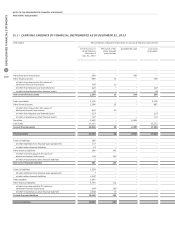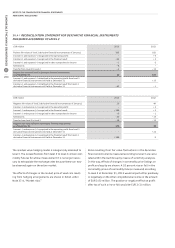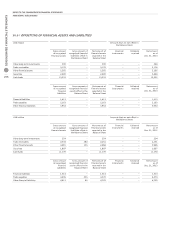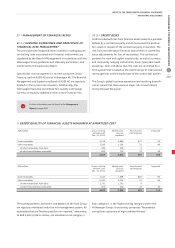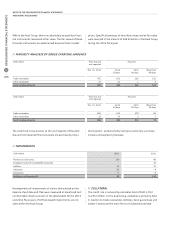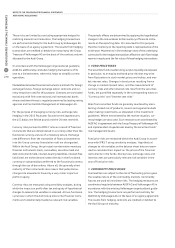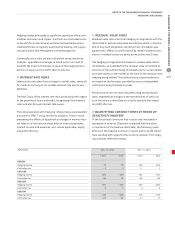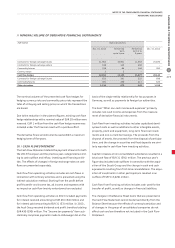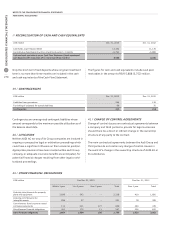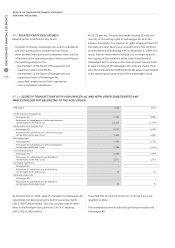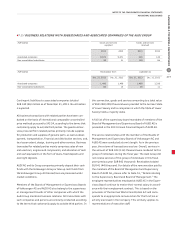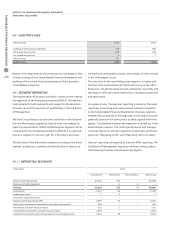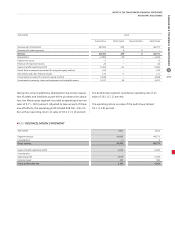Audi 2013 Annual Report Download - page 273
Download and view the complete annual report
Please find page 273 of the 2013 Audi annual report below. You can navigate through the pages in the report by either clicking on the pages listed below, or by using the keyword search tool below to find specific information within the annual report.
NOTES TO THE CONSOLIDATED FINANCIAL STATEMENTS
ADDITIONAL DISCLOSURES
CONSOLIDATED FINANCIAL STATEMENTS
270
B
These risks are limited by concluding appropriate hedges for
matching amounts and maturities. The hedging transactions
are performed centrally for the Audi Group by Volkswagen AG
on the basis of an agency agreement. The results from hedging
transactions are credited or debited on maturity by the Group
Treasury of Volkswagen AG on the basis of the contract volume
allocated to the Audi Group.
In accordance with the Volkswagen organizational guideline,
AUDI AG additionally concludes hedging transactions of its
own to a limited extent, where this helps to simplify current
operations.
Marketable derivative financial instruments (contracts for foreign
exchange futures, foreign exchange option contracts and cur-
rency swaps) are used for this purpose. Contracts are concluded
exclusively with first-rate national and international banks
whose creditworthiness is regularly examined by leading rating
agencies and Central Risk Management at Volkswagen AG.
For the purpose of managing currency risks, exchange rate
hedging in the 2013 fiscal year focused on the Japanese yen,
the U.S. dollar, the British pound and the Chinese renminbi.
Currency risks pursuant to IFRS 7 arise as a result of financial
instruments that are denominated in a currency other than the
functional currency and are of a monetary nature. Exchange
rate differences from the translation of financial statements
into the Group currency (translation risk) are disregarded.
Within the Audi Group, the principal non-derivative monetary
financial instruments (cash, receivables, securities held and
debt instruments held, interest-bearing liabilities, interest-free
liabilities) are either denominated directly in the functional
currency or substantially transferred to the functional currency
through the use of derivatives. Above all, the generally short
maturity of the instruments also means that potential ex-
change rate movements have only a very minor impact on
profit or equity.
Currency risks are measured using sensitivity analyses, during
which the impact on profit after tax and equity of hypothetical
changes to relevant risk variables is assessed. All non-functional
currencies in which the Audi Group enters into financial instru-
ments are fundamentally treated as relevant risk variables.
The periodic effects are determined by applying the hypothetical
changes in the risk variables to the inventory of financial instru-
ments on the reporting date. It is assumed for this purpose
that the inventory on the reporting date is representative of the
entire year. Movements in the exchange rates of the underlying
currencies for the hedged transactions affect the cash flow hedge
reserve in equity and the fair value of these hedging transactions.
//
FUND PRICE RISKS
The securities funds created using surplus liquidity are exposed,
in particular, to an equity and bond price risk that may arise
from fluctuations in stock market prices and indices, and mar-
ket interest rates. Changes in bond prices resulting from a
change in market interest rates, and the measurement of
currency risks and other interest rate risks from the securities
funds, are quantified separately in the corresponding notes on
“Currency risks” and “Interest rate risks.”
Risks from securities funds are generally countered by main-
taining a broad mix of products, issuers and regional markets
when making investments, as stipulated in the investment
guidelines. Where necessitated by the market situation, cur-
rency hedges are also used. Such measures are coordinated by
AUDI AG in agreement with the Group Treasury of Volkswagen AG
and implemented at operational level by the securities funds’
risk management teams.
Fund price risks are measured within the Audi Group in accord-
ance with IFRS 7 using sensitivity analyses. Hypothetical
changes to risk variables on the balance sheet date are exam-
ined to calculate their impact on the prices of the financial
instruments in the funds. Stock prices, exchange rates and
interest rates are particularly relevant risk variables in the
case of fund price risks.
//
COMMODITY PRICE RISKS
Commodities are subject to the risk of fluctuating prices given
the volatile nature of the commodity markets. Commodity
futures are used to limit these risks. The hedging measures are
coordinated regularly between AUDI AG and Volkswagen AG in
accordance with the existing Volkswagen organizational guide-
line. The hedging transactions are performed centrally for
AUDI AG by Volkswagen AG on the basis of an agency agreement.
The results from hedging contracts are credited or debited to
the Audi Group on maturity.


